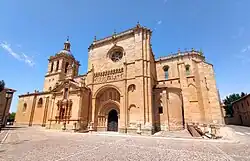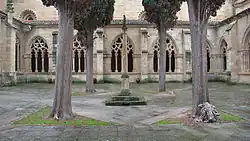Ciudad Rodrigo Cathedral
| Ciudad Rodrigo Cathedral | |
|---|---|
| Cathedral of Saint Mary | |
| Catedral de Santa María | |
 South façade in 2023. | |
| 40°35′56″N 6°32′06″W / 40.598941°N 6.535096°W | |
| Location | Ciudad Rodrigo |
| Address | 4, Plaza de Herrasti |
| Country | Spain |
| Denomination | Catholic |
| Website | catedralciudadrodrigo |
| History | |
| Status | Cathedral |
| Dedication | Mary, Mother of Jesus |
| Dedicated | 1160[1] |
| Architecture | |
| Style | Late Romanesque, Gothic |
| Administration | |
| Metropolis | Valladolid |
| Diocese | Ciudad Rodrigo |
| Clergy | |
| Bishop(s) | José Luis Retana Gozalo |
| Type | Non-movable |
| Criteria | Monument |
| Designated | 15 September 1889 |
| Reference no. | RI-51-0000059 |
The Cathedral of Saint Mary (Spanish: Catedral de Santa María) is a Roman Catholic cathedral located in Ciudad Rodrigo, Spain. It was declared Bien de Interés Cultural on 15 September 1889.[2]
The Renaissance composers Juan Navarro Hispalensis and his pupil Juan Esquivel Barahona were both choirmasters at the cathedral.
Architecture

The cathedral has four doors. In the episciple-side transept, there is a Gothic frieze with twelve figures from the Old Testament and a tympanum in which four Romanesque figures were placed in the Modern Age: from left to right Saint John, Saint Peter, Christ Pantocrator, Saint Paul, and Saint James. In the other transept the Puerta de Amayuelas opens, with a multi-lobed arch.
The tower was raised by Juan de Sagarvinaga at the end of the 18th century in a neoclassical style, after the collapse of the second tower during the Lisbon earthquake (the cathedral had had a third tower, which was demolished after the communal war).
See also
References
- ^ Casas, Narciso (4 February 2013). Historia y Arte en las catedrales de España [History and Art in the Cathedrals of Spain] (in Spanish). Madrid: Bubok Publishing. ISBN 978-8468632018.
- ^ Cerrato, Cruces Blázquez; Esquivel, Alberto Martín (2016-01-01). "Nuevos datos sobre los tesorillos de denarios romano-republicanos de Penhagarcía (Castelo Branco, Portugal) y del castro de Lerilla (Zamarra, Salamanca)". Actas XV Congreso Nacional de Numismática. Patrimonio numismático y museos. ISBN 978-84-89157-73-6.
